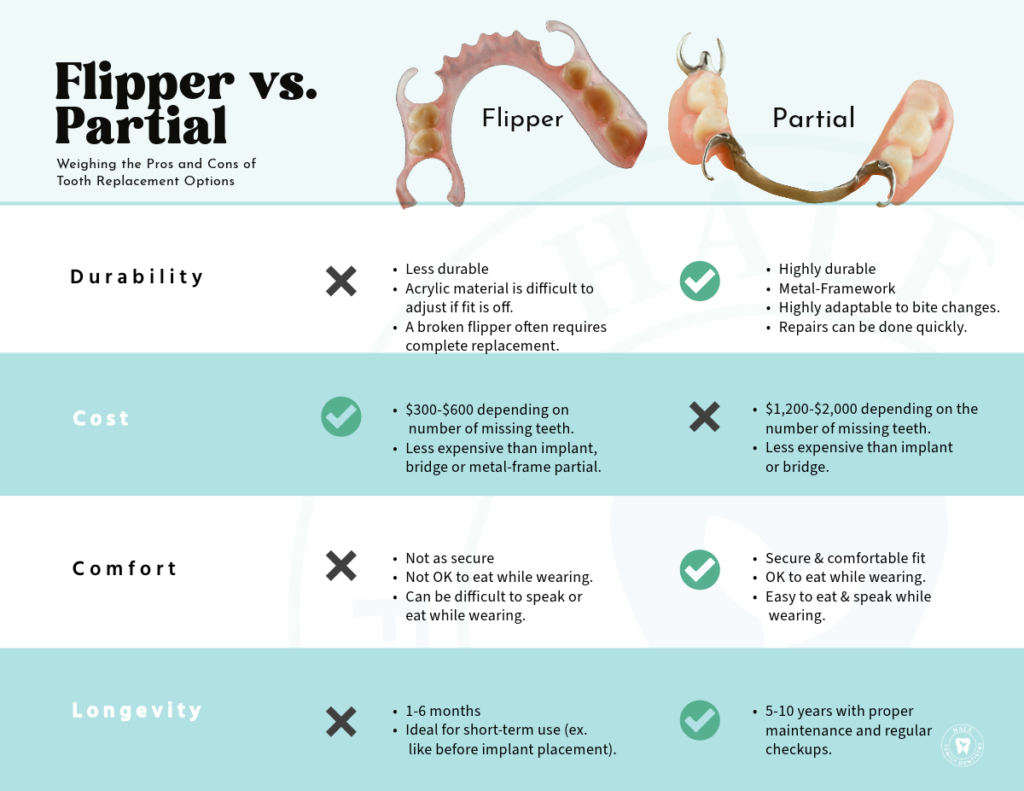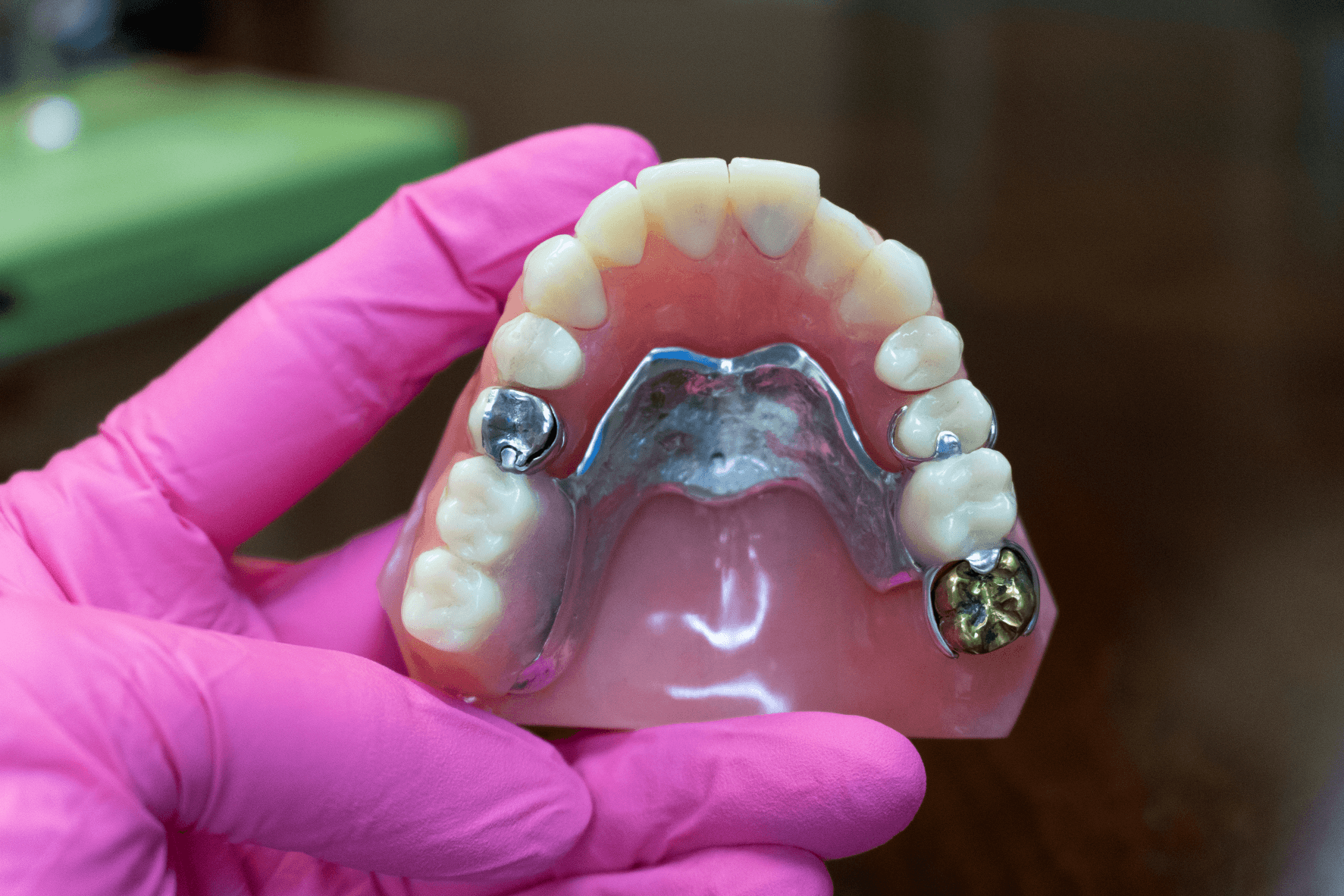Life happens and sometimes you need a tooth replacement. Today’s technological advancements mean there are options in terms of both look and feel. Some are acrylic, some are made of a metal framework, while others are made up of a combination of both. Determining the differences between a dental flipper and a partial denture is important when figuring out the best option for your needs.
Of course, your oral health, dental insurance coverage and budget enter the equation. Here, we will break down the definition of each, straight from the American Dental Association (ADA). Then, we take a deep dive into the benefits and uses of each, as well as potential downsides. Lastly, we share some industry secrets regarding whether a dental flipper or a partial denture is best.

What are Dental Flippers?
Also known as a flipper tooth, a dental flipper is an alternative tooth option that fits in your mouth like a retainer. It’s made of durable acrylic that’s conformed to your pallet. This flipper tooth often replaces one or two teeth. Using it to replace more than one tooth can be uncomfortable and not practical for its use. They are often mistakenly called a partial or denture. These appliances are sometimes worn in situations when the gums and bone heal following an implant.
Flipper Tooth Pros and Cons
Some patients are inclined to invest in dental flippers, but they’re not necessarily right for everyone. However, their advantages are that they’re affordable and can provide the look of teeth. They can result in a natural-looking smile that matches your existing teeth color. This is important for patients concerned about how their smile might be affected by the look of missing teeth. They’re also a good option when it comes to maintaining proper tooth spacing.
While these factors might make the case for getting a flipper, it’s important to be aware of some of the reasons they might not work for your situation. For one, they can cause discomfort if not fitted properly. They’re not as durable as a partial denture or dental implant. This is why they’re concerned a temporary solution. You should know that it’s not recommended to eat with the appliance in. This can damage it. Also, when weighing your options, it’s important to know that you can’t have additional teeth added to a dental flipper.
What are Partial Dentures?
Removable partial dentures are devices made with replacement teeth attached and offer a permanent solution. Each custom-made device rests on your top or bottom dental arch. The idea is that it fits and sits comfortably around your remaining natural teeth. These synthetic teeth look and function like real ones. This is a perk because metal partials can protect gum tissue and help prevent bone loss. Such an option uses discrete clasps to ensure a snug fight. It’s not fixed to your jaw like an implant but has the flexibility to be removed comfortably.
Partial Dentures Pros and Cons
You might not be a candidate for a partial denture if you don’t have a lot of adjacent teeth left. That’s because dentures, particularly partial dentures, require a foundation of healthy teeth for them to fit and work properly. Despite the advantages mentioned above, partials may pose challenges. For instance, you might notice food particles get trapped. There’s also the continued risk of tooth decay for existing natural teeth.
Adjusting to wearing partial dentures may take time, with soft foods recommended initially. It’s also crucial to be aware that partial dentures cannot be converted into full dentures. Sleeping with them is not recommended. Over time, adjustments may be necessary to ensure a comfortable and secure fit, underscoring the importance of regular maintenance and follow-up at your dentist.
Flipper vs. Partial: Which is Best for You?
Choosing between a flipper and a partial denture is a decision that your caring dental team can help you make based on the factors and scenarios outlined above. The choice ultimately depends on factors such as your oral health, lifestyle and the intended duration of use. Of course, cost enters the equation for most people. Dental insurance may or may not pay for repairs or added teeth. Check with your dental insurance to determine what might be covered and how much you might have to pay out of pocket.
What to Expect After a Dental Flipper and Partial
Like all appliances, flipper teeth do require care and maintenance. It’s important to keep it clean so bacteria don’t build up. You’ll want to use a soft toothbrush, warm water, and gentle cleaners like hand soap to keep the device in good condition. Don’t use toothpaste, as it’s too harsh. To keep the flipper tooth free from stains, avoid dark sauces, wines, and juices. Also, remember to store the flipper tooth in room-temperature water. Contact your dentist if you notice any issues with fit or appearance.
A dental partial is more involved in terms of the adjustment period and monitoring. We recommend wearing the partial for a week or over the weekend before scheduling an appointment for adjustments. It’s common for the partial to feel unfamiliar initially, and these adjustments help it seamlessly integrate into the mouth.
And just like a dental flipper, you’ll need to take action to protect your investment — and your smile. Both your partial denture and natural teeth must be kept very clean daily to reduce the chance of new dental decay forming. When not in use, always keep it in water or a denture solution. Otherwise, the acrylic will dry out over time, causing it to become brittle and affecting the fit.
Healthy Smiles Start Here
Whether a flipper or partial, it’s important not to neglect the basics. Keeping teeth and gums healthy contributes to the longevity of all prosthetics. Be sure to visit the dentist regularly for exams and teeth cleanings. Always brush and floss at least twice daily and follow a healthy diet.
Regular cleanings are essential, even with dentures or partials. It’s crucial to monitor the fit of the partial over time. Despite the mystery behind why the fit changes, routine check-ups allow us to catch and rectify any issues promptly, preventing prolonged discomfort or mouth sores that might otherwise go unnoticed for years.
Whatever your situation, our team at Hale Family Dentistry will steer you in the right direction so you can look and feel confident. When choosing between various tooth replacement options, let your dental team guide you. We can even do a free benefit check to see if a crown is covered on your dental insurance. Request an appointment online and find the best treatment for your dental needs.


